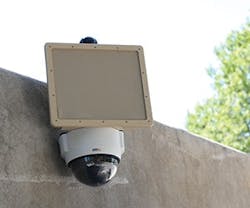It sounds too good to be true – a surveillance device that spots moving objects in the dark, offers a 90-degree field of coverage, and won’t be affected by adverse weather.
It’s not often that facility managers can borrow the same detection technology used at airports, military bases, and chemical refineries, but radar is increasingly used for perimeter protection at commercial properties.
Could radar be your next security purchase? Learn more below.
Why Radar?
Most buildings struggle to provide continuous coverage of large areas without using a large patrol force or a host of detection equipment. Surveillance cameras are a typical fix, but they have their limitations.
“With cameras alone, it’s difficult for a security guard to detect people at far ranges,” says Logan Harris, CEO of SpotterRF, a manufacturer of compact ground radar units. Poor weather or lighting conditions can also hamper identification with even the most robust thermal cameras.
“Radar works 24 hours a day in sun or dark,” says David Calabrese, sales consultant for critical infrastructure protection with Honeywell Automation & Control, a supplier of radar options. ”It provides greater area coverage for a fraction of the cost of video analytics, fence line sensors, buried cables, and other technologies.”
As opposed to a stand-alone system, however, radar allows you to supplement and extend your existing security measures. Use it to create smart perimeter protection by having individual components communicate with one another.
“The three phases of an effective security system should include detection, identification, and response,” Harris explains. “Radar addresses tracking, cameras support recognition, and an alarm system or security guards enable resolution.” PageBreak
How Does It Work?
Radar uses radio waves to canvas a 90-degree field, similar to how the police track speeding cars or airports monitor approaching planes. This form of ground radar detects movement.
“Radar is like sticking a GPS tracker on an uncooperative target at 1,000 meters away – now you know exactly where they are,” says Harris.
This technology allows a guard to perform security tasks separate from monitoring, Calabrese says. When motion is detected, the system will cue a camera to the location. This alerts the operator to investigate something on the property.
Unlike how a weather station watches a storm, this radar can’t distinguish what kind of object it is tracking, Harris notes. Radar will detect the motion of a deer, a moving vehicle, or a trespasser. It’s up to your security team to identify whether the movement is a threat or not.
“However, rules can be added to the radar platform to determine which targets are higher priorities,” Calabrese adds. “Components such as speed, direction, and proximity can filter out friendly targets traveling into alarm zones.”
For example, a security vehicle or guard on patrol needs to move in and out of restricted areas without activating an alarm response. Pre-established variables can help security determine if a radar cue has approved access or requires further scrutiny.
Where Can It Be Used?
Unlike other technologies, radar doesn’t generate a heat signature or penetrate objects, Harris says. Properties with constant motion (like a busy parking lot), dense foliage, or other structures in the line of sight aren’t suitable environments.
A hospital or downtown office is unlikely to benefit, but a college campus might want to know if students are wandering into off-limits areas. Likewise, a shopping center may be concerned about after-hours activity in the parking lot or near its loading docks.
Radar can provide coverage from 350-12,000 meters, says Calabrese. Properties that are found in secluded locations, serve as critical infrastructure, or have large grounds typically find radar a useful addition. It can even protect vulnerable assets, such as a ground solar array, a power plant, or exposed building systems.
Units can be mounted on the ground, a pole, or high on a building exterior. Surge protection, weather proofing, and low energy consumption (less than 10 W) ensure that units will function for years on end with little maintenance.
Depending on your security needs, one unit may suffice to monitor a specific area, whereas other locations will install a handful of sensors so the whole property is covered.
Owners can expect to pay approximately $600 per acre, or around $12,000 for an average unit, says Harris. While the investment price may seem steep, calculate how much it would cost to get the same area of continuous coverage with other security measures.
You can also determine what kind of risk your property would incur if you didn’t have a way of automatically detecting movement and expediting the identification of potential threats.
Radar won’t replace your cameras or security guards, but it will make your surveillance operation more agile and intelligent.
Jennie Morton [email protected] is associate editor of BUILDINGS.
About the Author
Jennie Morton
A former BUILDINGS editor, Jennie Morton is a freelance writer specializing in commercial architecture, IoT and proptech.
